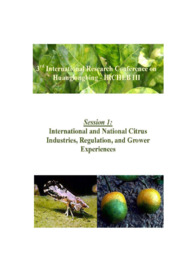HLB BioMath: sentinel network and research.
HLB BioMath: sentinel network and research.
Author(s): BARBOSA, F. F. L.; ANDRADE, E. C. de; NASCIMENTO, A. S. do; BARBOSA, C. de J.; SILVA, S. X. B.; ALENCAR, J. A. de; NORONHA, A. C. da S.; ISHIDA, A. K. N.; GARCIA, T. B.; NAVA, D. E.; BUENO, B.
Summary: The citrus Huanglongbing (HLB), recognized as the most devastating citrus disease worldwide, was detected in Sao Paulo state, Brazil in 2004. The HLB management strategy employed in São Paulo is based on preventing new infections by reducing the inoculum (certified planting seedlings, psyllid control and removal of symptomatic plants). However, HLB continues to disseminate, reaching two neighbor states. In Brazil, citrus is cultivated country-wide (88% of the microregions produce citrus, responding for more than 30% of the planted area). If this dissemination pattern persists, there is a risk of emergence of HLB in areas not yet affected. To face this problem, exclusion strategies and early detection/eradication are crucial, specifically, tools, information and support for the action of phytosanitary defense agencies. The objectives of this Network are generate information that allows to defense phytosanitary agencies prioritize, anticipate or reassess actions relating to the exclusion or eradication of HLB, focusing on preventive actions to areas still unaffected. Since 2010, dataset (presence/absence of vector and bacteria, vector population measurements, etc.) are being obtained from different eco-regions of Brazil: south (cold), northeast (including semi-arid region) and north (amanzon). The analysis of the data until now shows that in the south and north regions the presence of the vector is uncommon or even rare. In contrast, in the northeast the presence is very common, and in the semi-arid region, the vector occurs, but in less abundant and sporadic fashion. Symptomatic plants and insect collected in all regions were tested and did not show the presence of the bacteria.
Publication year: 2013
Types of publication: Abstract in annals or event proceedings
Unit: Embrapa Semi-arid Region
Keywords: Bacteria, Citrus, Citrus Huanglongbing (HLB), Fruta cítrica, HLB
Observation
Some of Embrapa's publications are published as ePub files. To read them, use or download one of the following free software options to your computer or mobile device. Android: Google Play Books; IOS: iBooks; Windows and Linux: Calibre.
Access other publications
Access the Agricultural Research Database (BDPA) to consult Embrapa's full library collection and records.
Visit Embrapa Bookstore to purchase books and other publications sold by Embrapa.

